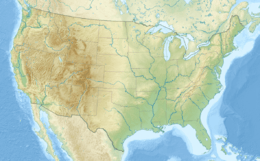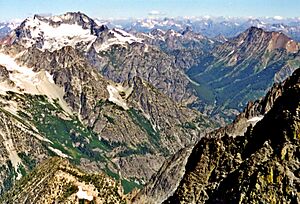Martin Peak (Washington) facts for kids
Quick facts for kids Martin Peak |
|
|---|---|
| Highest point | |
| Elevation | 8,511 ft (2,594 m) |
| Prominence | 2,111 ft (643 m) |
| Isolation | 2.34 mi (3.77 km) |
| Parent peak | Bonanza Peak (9,511 ft) |
| Geography | |
| Location | Glacier Peak Wilderness Chelan County Washington, U.S. |
| Parent range | North Cascades |
| Topo map | USGS Holden |
| Type of rock | schist, marble |
| Climbing | |
| First ascent | 1936 |
| Easiest route | class 4 scrambling |
Martin Peak is a tall mountain in Washington state. It stands at 8,511 feet (2,594 meters) high. You can find it in the North Cascades mountain range, specifically in Chelan County.
This peak is about 80 miles (129 km) northeast of Seattle. It's also just 3 miles (5 km) northwest of a small community called Holden. Martin Peak is part of the Glacier Peak Wilderness area. The Wenatchee National Forest manages the land around it.
Martin Peak is quite important among mountains in Washington. It ranks as the 56th highest peak in the state. It's also 54th on a special list called the "Bulger List," which names the highest peaks in Washington. The closest taller mountain is Bonanza Peak, which is about 2.35 miles (3.78 km) to the west. Water from Martin Peak, including meltwater from a glacier, flows into Lake Chelan. The first person to climb Martin Peak was Ida Zacher Darr in July 1936.
Weather Around Martin Peak
The area near Martin Peak is a bit drier than places to the west. This is because it's located east of the Cascade Range. Summers here can be warm, and you might see thunderstorms sometimes.
Most weather systems come from the Pacific Ocean. They usually travel northeast towards the Cascade Mountains. When these weather systems reach the tall peaks of the Cascade Range, they are forced to rise. As they go higher, they drop their moisture as rain or snow. This process is called Orographic lift. Because of this, the North Cascades gets a lot of rain and especially heavy snowfall in winter. Martin Peak is so tall that it can have snow on its slopes in late spring and early fall. Winters on the mountain can be very cold.
How Martin Peak Formed
The North Cascades mountains have a very rugged landscape. You'll see sharp peaks, long ridges, and deep valleys carved by glaciers. These amazing shapes were created by geological events that happened millions of years ago. These events caused huge changes in elevation, which also led to different climates and types of plants in the area.
The Cascade Mountains started forming millions of years ago, during the late Eocene Epoch. This happened because the North American Plate slowly moved over the Pacific Plate. This movement caused many volcanic eruptions over a long time. For example, Glacier Peak, a large volcano, began forming about 16.5 miles (26.6 km) west-southwest of Martin Peak.
Also, about 50 million years ago, small pieces of the Earth's crust, called terranes, came together to form the North Cascades. During the Pleistocene period, which was over two million years ago, glaciers moved across the land many times. As they moved, they scraped and shaped the landscape, leaving behind rock debris. The "U"-shaped valleys you see today were formed by these glaciers. The combination of land being pushed up (called uplift) and cracks in the Earth's crust (called faulting), along with the action of glaciers, created the tall peaks and deep valleys of the North Cascades.




